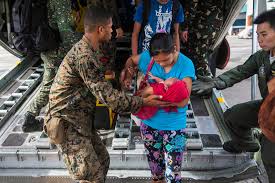As international aid streams into the Philippines after Typhoon Haiyan killed at least 2,000 people and left 20,000 missing, the call to donate is again being posed to Carlmont students.
“Donations will definitely help a bunch,” said junior Jack Carlson. “The money will be put to good use in restoring buildings and helping to repair damage.”
Fellow junior Keenan Allen said, “[How much the aid helps] depends on the donation. [But] the money helps because it gets people what they need.”
Four Carlmont students interviewed said that their families had not donated to the Philippines. However, they were sympathetic to the victims.
Junior Andrew Yazhgur said the United States should give “as much as necessary, and then more” in terms of donations.
Allen predicted that the United States will give “a lot” of aid, “but not entirely in monetary form.”
Thedailybeast.com reports the United States has given $22.5 million as of Nov. 15, not counting contributions from private induviduals and organizations.
Patrick Rooney, associate dean at Indiana University’s Lilly Family School of Philanthropy, expects that individual donations to relief agencies will reach the third-highest amount ever for an overseas disaster, according to USA Today.
The United States is also contributing 55 metric tons of emergency food along with providing aid and relief through military aircraft and helicopters, which can carry goods to hard-to-reach areas.
The USS George Washington aircraft carrier arrived at the Philippines on Nov. 14 full of food, water (its two nuclear reactors desalinate water, producing 400,000 gallons a day), supply planes, and a 51-bed hospital ward, according to jalopnik.com
Carlson said he would want any donation of his to go “directly to the people. Then they could use it for what they need, not what the government thinks they need.”
Allen simply said he would want his contribution to go “wherever it’s needed.”
All three students that were interviewed named the American Red Cross as their organization of choice to donate through, as it was the most well-known.
However, junior Simon Bacon disagreed and said, “I read that the money in their charity doesn’t actually go towards the cause. A lot of it pays for their salaries [instead]. I believe the number I read was 17 cents for every dollar.”
“I would probably choose a lesser known charity if I were to donate, so I could make sure that my money was actually being used for a good cause,” said Bacon.
Despite such concerns, the Red Cross still meets all of the “Standards for Charity Accountability” according to bbb.com’s charity review.
Money.cnn.com estimates the average amount as nine cents per dollar instead, and notes that charities like the Red Cross need money to run their organizations, pay employees, raise funds and ensure the money is used properly.
Charity evaluator CharityWatch states that, overall, nine cents per dollar is very low compared to other charities and nonprofit organizations. CharityWatch further advises that consumers donate to charities that use at least 75 percent of donations for direct aid, which the Red Cross far exceeds at 91 percent.
“These funds ensure proper oversight of donations and provide for the overall administration of our organization,” a Red Cross spokeswoman said. “We are proud that we keep these expenses low and that we invest such a large amount in our humanitarian services.”
Carlmont itself is participating in the donating spirit.
The Girl’s Basketball junior varsity and varsity teams are planning to run a clothes drive, headed by varsity player Anisah Smith.
Carlmont Psychology teacher Michelle McKee has written on her whiteboard “Help the Philippines” with links to the International Rescue Committee (www.rescue.org) and World Food Program (Text AID to 27722 to pledge $10).
“Donate now!” the board urges.

